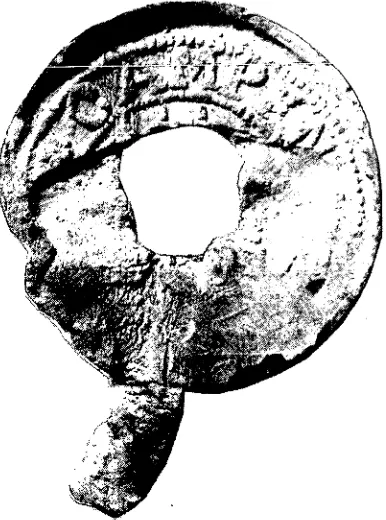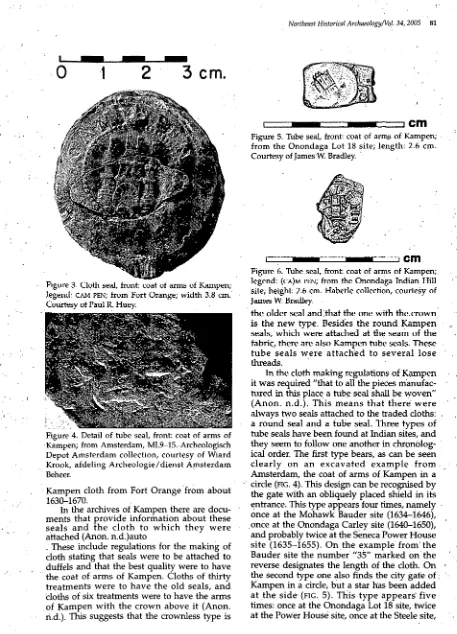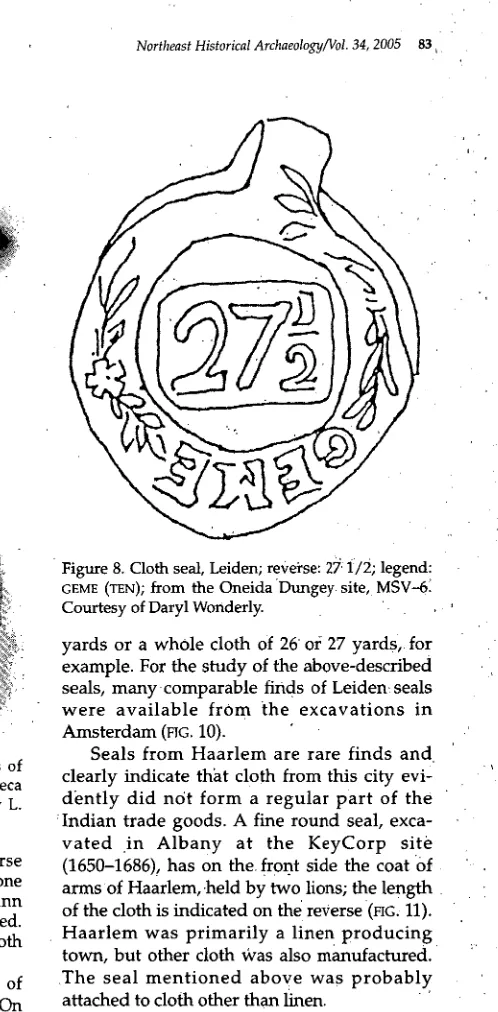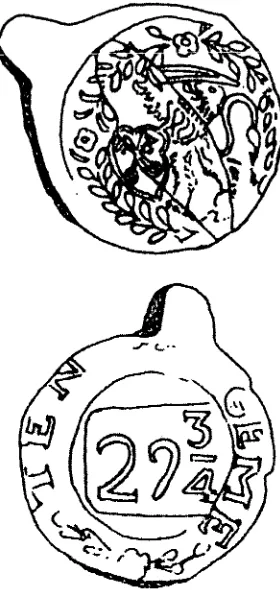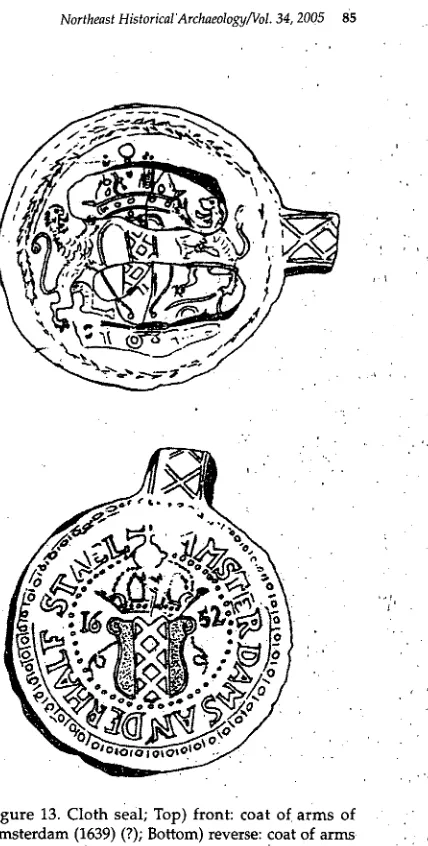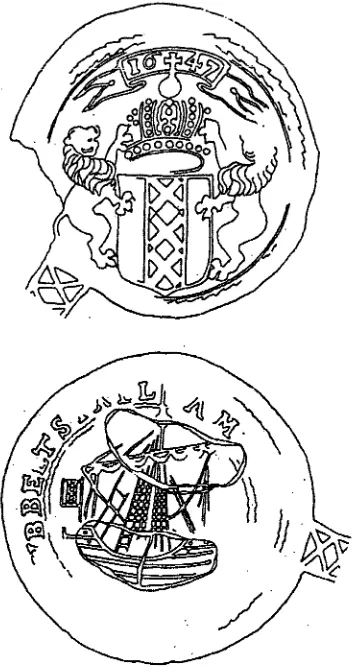Northeast Historical Archaeology
Volume 34
From the Netherlands to New Netherland:
The Archaeology of the Dutch in the Old and New
Worlds
Article 4
2005
Cloth Seals at Iroquois Sites
Jan M. Baart
Follow this and additional works at:
http://orb.binghamton.edu/neha
Part of the
Archaeological Anthropology Commons
This Article is brought to you for free and open access by The Open Repository @ Binghamton (The ORB). It has been accepted for inclusion in Northeast Historical Archaeology by an authorized editor of The Open Repository @ Binghamton (The ORB). For more information, please contact ORB@binghamton.edu.
Recommended Citation
Cloth Seals at Iroquois Sites
Cover Page Footnote
The inventory of the Kampen, Leiden, and Amsterdam seals excavated in the United States is based on
personal research, personal communications, publications of the William M. Beauchamp Chapter of the New
York State Archaeological Association, and information from the following individuals: Monte Bennett, James
W. Bradley (ArchLink, Charlestown, Massachusetts), William Carter (Lewis Morgan Chapter, New York State
Archaeological Association), Gordon DeAngelo (Chittenango, New York), Charles F. Hayes (for~erly of the
Rochester Museum and Science Center), Paul R. Huey (New York State Office of Parks, Recreation and
Historic Pr~servation, Bureau of Historic Sites, Waterford, New York), Donald A. Rumrill, Daryl Wonderly
(Chenago Chapter, New York State Archaeological Association, Munnsville, New York), and Charles F. Wray.
['
I,:
I '
Northeast Historical Archaeology/Vol, 34,2005 77
Cloth Seals at Iroquois Sites
JanM. Baart
Textiles represent a very significant component of the Dutch goods that were exported to New Netherland for trade with the Iroquois Indians. These textiles varied greatly in quality. These differences were indicated on lead cloth seals that were affixed to the cloths. The lead cloth seals that are excavated at Iroquois sites provide useful information about the origins and quality of the traded cloth; They also .are a source of information about Dutch textile manufacture in the 17th century, a period during which the cloth industry was the most important urban industry in the Netherlands. Amsterdam was the staple market from , which a,n kinds of textiles from various towns a,:d cities were exported. Amsterdam itselJ was specialized in the dyeing of cloth. A catalogue of the lead cloth seals found at Iroquois and Dutch sites, in New Netherland reveals that. between 1630 and 1670, four Dutch cities were represent~'d: Kampen, Leiden, Haarlem, and Amsterdam. There are both round and tubular seals from Kampen. Leiden seals are prima7;ily round. The Amsterdam seals found in Iroquois sites are all seals that verify the quality of the dyeing of the doth. ' Haarlem is represented by just one seal, found in Albany, suggesting that cloth from Haarlem was used by the Dutch .colonists themselves, rather than for the trade with the Iroquois. The numbers scratcl:zed on cloth " seals indicate cloth lengths. Actual textile fragments excavated at some Iroquois sites represent coarse duffels probably from Kampen as well as finer cloth types probably from Amsterdam. Based on the excavated cloth seals, it can be concluded that most of the cloth fC!r trade with the Iroquois came from Kilmpen.
Les textiles sont une composante significative des den'rees neerlandaises exportees pour ,la traite avec les Iroquois. La qlialite de ces textiles varia it enormement. Les sceaux ii etoffe en plomb mis au jour sur les sites Iroquois fournissent des informations utiles ii propos des origines et de la, qualit¢ des etoffes echangees ai1Jsi que sur la fabrication de textile neerlandais au XVIIe siecle, une periode pendant laquelle I:industrie textile constituait la plus importante industrie urbaine des Pays-Bas. Alflsterdam fut Ie marche principal ii partirduquel une variete de textiles de diverses villes ont ete exportes, mais fut aussi un centre de teintured' etoffe. Un catalogue de sceaux ii etoffe en plomb mis au jour sur des sites neerlandais'ii New Netherland revele qu'entre 1630 et 1670, quatre villes neerlandaises etaient representees: Kampen, Leiden, ' ' Haarlem et Amsterdam. Dessceaux de formes ronde et tubulaire proviennent de Kampen alors que ceux'de Leiden sont principalement de forme ronde. Haarlem n'est representee que par un.seul sceau ayant ete mis au jour ii Albany, suggerant que Haarlem n'est pas ete unJournisseur d'etoffe important dans la traite avec' les Autochtones. Les sceaux d'Amsterdam trouves sur des site~ Iroquois sont tous des sce~ux servant ii veri-fier la qualite de la teinture de I'etoffe. Les nombres graves sur les sceaux,.ii etoffe illdiquent la longueur de
l' etoffe. Des fragments d' etoffe mis au jour sur quelques sites Iroquois sont de lourds lainages provenailt probablemen,t de Kampen ainsi que des varietes d' etoffes plus raffineesprovenant probablement d'Amsterdam. L'etude des sceaux ii etoffe permet donc d'arriver ii la conclusion que la majeure partie des etoffes echangees provenait de Kampen.
Textiel vertegenwoordigt een belangrijk deel van 'de Nederlimdse goederen die:naar Nieuw Nederland werden geexporteerd voor di! handel met de Irokezen. Er vallen verschillende kWaliteiten in laki!ns te onderscheiden. Deze verschillen 'werden aangegeven op lake'nloden die aan de lakens werden'aangebracht: De lakenloden die werden opgegraven in de nederzettingen van de Irokezen'geven nuttige informatie over de 'herkomst en kwaliteit van de verhandelde textiel. Tevens vormen zij een bron voor de kennis va'n de Nederlandse lakenindustrie in de 17e eeuw, een periode 'waarin deze de belangrijkste stedelijke.nijverheid was in Nederland. Amsterdam was het middelpunt van de' handel vqnwaar allerlei soorten textiel, afkomstig uit verschillende steden, werden geexporteerd. De stad zelJ was gespe,cialiseerd in het verven van lakens.
'Een catalogus van de lakenloden die voornamelijk gevonden werden in de nederzettingen van de Irokezen in Nieuw Nederland laat zien-dat er tussen 1630 en 1670 vier NederlandsNteden-bij de handel in lakens betrokken waren, te weten: Kampen, Leiden, Amsterdam en Haarlem. Uit Kampen komen zowel ronde als cilindrische loden, de zogenoemde pijploden. De lakenloden l;lit Leiden bestaan voor het merendeel uit
78 Dutch Cloth SealslBaart
ploden. De Amsterdamse lakenloden uit de indiaanse nederzettingen zijn loden die de kwaliteit van het verven aangeven. Haarlem is met een lakenlood vertegenwoordigd, gevonden in Albany, wat suggereert dat lakens uit Haarlem gebruikt werden door de Nederlandse kolonisten en niet bestemd waren voor de handel met de indianen. De cijfers die op de lakenloden zijn aungegebracht geven de iengte van de geleverde lakens aan. Stukken van de lakens zelf, die werden opgegraven in de nederzettingen van de Irokezen, bestaan zowel uit grove duffels, uit Kampen en Leiden, als fijnere lakens, uit Amsterdam. De opgegraven lakenloden geven aan dat de meeste lakens verhandeld met de Irokezen uit Kampen kwamen.
Textiles formed an important part of the trade goods that found their way from Amsterdam in the Netherlands to the various Iroquois sites in central New York State, then New Netherland. Several towns in the Netherlands became especially involved in this market. Because of the rapidly developing trade contacts with Virtually all parts of the world during the 17th century, the market for these trade goods greatly expanded. Cloth of a great variety in qualities was therefore pro-duced, depending on the type of market that was being supplied. Broadly speaking, three types of cloth were produced. First, there was cloth of a very fine quality, which was particu-larly used for prestigious gifts or as valuable merchandise. Cloth of such quality, for example, was offered to the emperor of Japan in 1608 in order to obtain access to the large Japanese market (Hudig 1923: 34-35). Second, in Europe, but also elsewhere, a regular but good quality of cloth was in high demand. This type of cloth formed the major portion of cloth exports. A third type of cloth was mediocre. Because mediocre qualities were produced everywhere, cloth of this quality was less likely to be considered a trade good.
In the Iroquois sites different types of finds bear witness to the lively trade with the local population: cloth, blankets, and complete jackets were traded. At some sites pieces of cloth and jackets have been found, especially in graves (Wray 1985: 103-112; Baart 1987: 7, FIG. 8). They have been preserved, thanks to the presence of copper kettles buried along with them. Seals were attached to the cloth used for trade, and fragments of lead seals or sometimes even complete seals that are found are important sources of information about the orgin and the quality of the cloth. On the one hand they provide evidence of cloth produc-tion and market in the Netherlands, while on the other they reveal the quantities and quali-ties of the cloth that was offered to the
Iroquois Indians. Documents refer to this trade cloth as, for instance, "duffels of Holland linens" (Ceci 1980: 838-847). These records do not always indicate the origin or quality of the cloth. In combination with the excavated pieces of textile, cloth seals form a unique source, not only for the reconstruction of the European-Native American trade, but also for the study of the various cloth products of Dutch towns.
The cloth industry was the most important urban industry in the 17th-century Netherlands. A considerable part of the popu-lation derived its work and livelihood from it. In Leiden, the pre-eminent Dutch textile town of the Netherlands-perhaps the most impor-tant textile town of 17th-century Europe-not less than a quarter of the population worked in the textile industry (Posthumus 1939). Cloth was the most important export product, as grain was the the most important import and transit commodity. The production of cloth was very labor-intensive. Numerous specific actions were performed by craftspeople. In the clothmakers' hall of Leiden several paintings have been preserved which give an impression of this work. As a rule, the various crafts-people performed their duties at home. A painting of the interior of a weaver's house suggests that many of these workers were not very wealthy (Rombouts 1656). It was the clothiers, those who organized this work and at the same time sold the products, who often managed to gain a degree of wealth.
Northeast Historical Archae%gy/Vo/. 34, 2005 79
I I
I , I
Figure L Detail of the entrance gate of the Municipal Museum, De Lakenhal, at Leiden. Courtesy'of Paul R.
H u e y . ' ,
and largest is the clothmaker's hall of Leiden, seals found in Iroquois sites have been as depicted in the painting by Susanna van stamped with the coat of arms of Amsterda:m Steenw~jk in the collection of the Museum de and the date of issue of the stamps. In the sam-Lakenhal in Leiden. It was built in 1639 and pling'hall, after the inspection of the dyed 1640. The entrance is made of sandstone and cloth, seals were attached with marks such as decorated with the sculpture of a pile of cloth "AMSTERDAM STAEL," "AMSTERDAM(S) ANDERHALF
to which the sculptor has attached a faithfully STAEL," "AMSTERDAM DUBBELT STAEL," OR
"AMS-reproduced cloth seal (FIG. 1). Sometimes one, TERDAMS GROOT DUBBELT STAEL" (Baart, et a1. ' but often many, seals were attached to the 1977: 112). Examples of the various qualities cloth. They indicated first the town of produc- .mentioned above have been found, both used tionand subsequently, by means of marks, the and unused, in excavations in Amsterdam. quality of dyeing or the measurements. For The sampling masters were important people example, a fragment of textile was found in who sometimes held several offices in city. The the center of Amsterdam with three seals from syndics of the clQth guild, the Staalmeesters, Leiden. On the front side of the seals one Can had themselves portrayed by Rembrandt Van see the coat of arms of Leiden with marks for Rijn. ' '
the quality of dyeing and the length of the In any case, after dyeing, the wet cloth was cloth, while on the reverse is the lion with hanged to dry on so-called "frames." There ( sword (Noordkerk 1748: 116; Baart 1988b: 297, was roo;n for these frcimes in several places in
FIG.: 19). the city. They were located near the sampling, Amsterdam was not only the central hall or in the' city 'outskirts. The municipality' market from which all kinds of textiles coming located these places outside the city for envi-from various towns were exported, but it was ronmental reasons. The waste water of the dye also a town of importance in the dyeing of works could pollute the water of the City's cloth. Often the finely woven cloths of other cilr1als, which was used for several other pur- . towns were dyed in Amsterdam. In 1591 poses.
80 Dutch Cloth SealslBaart
(Egan 1994: 1, FIG. 2). It dates from around 1275
and was excavated in the medieval town center of Amsterdam. The text on it says "VAN LEYDEN," and the seal also has the single key on it representing the patron saint of Leiden, St. Peter. From 1300 onwards, the seals of Leiden have crossed keys.
In the inventory and identification of the Dutch cloth seals excavated in the State of New York, the former New Netherland, this writer found lead seals that originated from four cities, namely Kampen, Leiden, Haarlem, and Amsterdam. The seals all came from Iroquois Indian sites dating between 1630 and 1670, and historical documents refer to the types of cloth that likely accompanied these seals. On December 14, 1634, Harmen Meindertsz van den Bogaert described in his journal a Mohawk Iroquois chief who had an "idol which was a marten's head with pro-truding teeth, covered with red duffel-cloth." On January 3, 1635, he discussed with the Indians the exchange of beaver skins for cloth and other trade items (Gehring and Starn a' 1988: 5, 15). An invoice of goods sent by Kiliaen van Rensselaer to New Netherland probably in April 1634 gives some idea of the kinds of cloth that were sent: "three bolts of coarse cloth and one of somewhat finer, cost /52.10" (van Laer 1908: 263).
Regarding the quality of the cloth, Kiliaen van Rensselaer wrote from Amsterdam on May 3,1640, to his partner in Leiden that "the Campen duffels I have also in the house. They contain a good many yards more than those from Leyden and are at least two or three fin-gers wider." On May 7 he wrote
I shall expect the three blankets at the earliest opportunity and also examine closely into the respective qualities of the Campen and Leyden duffels. We were already last Saturday busy comparing them. In general the Campen duf-fels are much wider than those from Leyden, but that is not strange as I had them made that way on purpose. The pieces are also about 10 yards longer than those from Leyden. The wool of one of the consignments from Campen, for I have two of them, is also fully as good as that of the other but the red color of the Leyden duf-fels is superior. We shall look into this more closely yet and weigh every piece to see how much wool it contains, and for our guidance make a note of the quality, the price, the color and whatever else is of importance (van Laer
1908: 468).
Figure 2. Cloth seal, front: coat of arms of Kampen; legend: CAMPEN; from Steele site, 6716/100. Courtesy
of Judy 1. Ozone, Rochester Museum and Science Center.
The lead seals found at Indian sites enable us to learn more about these "duffels." A total of 26 round lead seals could be identified as coming from Kampen. There are two types. Both of them have the image of the town gate of Kampen, but they differ in the absence or presence of a crown above the town gate and in the placement of the name CAMPEN. The type without the crown has the continuous word CAMPEN (FIG. 2), whereas the type with
the crown has CAM PEN divided in two parts embossed on either side of the crown (FIG. 3). The only round examples of the CAMPEN type
without the crown in the period from about 1635 to 1650 are one from the Seneca Steele site, dated 1635 to 1655, and perhaps two examples from the Seneca Power House site, also dated 1635 to 1655 (see FIG. 2).
All the other Kampen seals have their crowns above the town gates. The examples of this type (see FIG. 3), with the crown above the coat of arms of Kampen and flanked with the legend CAM PEN, were found at a variety of
o
·1
2
3
em.
Figure 3. Clgth seal, front: coat of arms of Kampen; legend: CAM PEN; from Fort Orange; width 3.8 cm.· Courtesy of Paul R. Huey.
Figure 4. Detail of tube seal, front: coat of arms of 'Kampen; from Amsterdam, ML9-15 .. Archeologisch Depot Amsterdam collection, courtesy of Wiard Krook, afdeling Archeologie / dienst Amsterdam Beheer.
. Kampen cloth from Fort Orange 'from about 1630-1670.
In the archives of Kampen there are docu-ments that provide information about these s.eals and the cloth to which they were attached (Anon. n.d.)auto
. These include regulations for the making of cloth stating that seals were to be attached to . duffels and that the best quality were to have the coat of arms of Kampen. Cloths of thirty treatments were to have the old seals, and Cloths of six treatments were to have the arms of Kampen with the crown above it (Anon. ri.d.). This suggests that the crownless type is
Northeast Historical Archaeoiogy/Vol. 34, 2005 81
C=~"~~"-=~Icm
Figure 5. Tube seal, front: coat of arms of Kampen; . from the Onondaga Lot 18 site; length: 2.6 cm. Courtesy of James ·W. Bradley. .
C=~"~~"-=~Icm
Figure 6. Tube seal, front: coat of arms of Kampen;. legend: (CA)M PEN; from the Onondaga Indian Hill site; height: 2.6 cm. Haberle collection, courtesy of James
w.
Bradley. .the older seal and,that the one with the crown is the new type. Besides the round Kampen seals, which were attached at the seam of the fabric, there are also Kampen tube seals. These tube seals were attached to several lose threads.
82 Dutch Cloth Seals/Baart
Table 1. Distribution of Lead Cloth Seals by Type and Site.
Seal type Sites Date N
Round seals with legend CAMPEN POlver House site 1635-55 2 (7)
without crown (FIG. 2). Steele site 1635-55 1
Round seals with legend CAM PEN Power House site 1635-55 1
with crown in between (FIG. 3) Steele site 1635-55 1
Mitchell site 1646--60 4
Fort Orange site 1648--64 1
Dungey site 1649-62 4
Lot 18 site 1650-55 2
Indian Castle site 1655-63 1
Dann site 1660-75 4
Indian Hill site 1663-82 3
Pompey area 2
Tube seals with coat of arms of Kampen Bauder site 1634-46 1
in circle (FIG. 4) Power House site 1635-55 2 (?)
Carley site 1640-50 1
Tube seals with coat of arms of Kampen Bauder site 1634-46 1
in circle and star (FIG. 5) Power House site 1635-55 2
Steele site 1635-55 1
Lot 18 site 1650-55 1
Tube seals with coat of arms of Kampen Fort Orange site 1648--64 1
and legend CAM PEN (FIG. 6) Dungey site 1649-62 3
Dannsite 1660-75 7
Sullivan site 1660-77 1
Indian Hill site 1663-82 1
Tube seals of Leiden with indication Power House site 1635-55 XXVII 3
of length (FIG. 7) Carley site 1640-50 XXVI 1
Stone Quarry site 1645-55 XXVII 2
Dannsite 1660-75 2
Indian Hill site 1663-82 XIV 1
Round seals of Leiden with legend Dungey site 1649-62 1
GEMETEN (FIG. 8)
Round seals of Leiden possibly with the Carley site 1640-50 1 Leiden coat of arms
Amsterdam 1/ Anderhalf Stael" seals Power House site 1635-55 2
1607/1639(?) (FIG. 12) Stone Quarry site 1645-55 1
Amsterdam 1/ Anderhalf Stael" seals Steele site 1635-55 1
1639(?)/ 1652 (FIG. 14) Dungey site 1649-62 2
Lot 18 site 1650-55 1
Dannsite 1660-75 1
and once at the Bauder site. The third type has the city gate with the name of CAMPEN around
it (FIG. 6). These examples appeared for the first time around 1660. A total of 13 examples have been recorded (TAB. 1).
. Figure 7. Tube seal, Top) front: coat of arms of Leiden; Bottom) reverse: XXVII; from the Seneca Power House site, 6107/24. Courtesy of Judy L.
Ozone, Rochester Museum and Science Center.
side; the length was marked on the reverse side (FIG. 7). On two seals, one from the Stone Quarry site and one from the Seneca Dann site, the merchant's mark HG has been printed.
The Leiden tube seals with indications of cloth lengths were found 'at several sites (TAB. 1)
. From about 1650 onwards, the length of the cloth was also marked on ro1.illd seals. On these seals we will find the word GEMETEN
("ineasured") and the length. Such an example was excavated at the Oneida Dungey site (FIG.
8). A complete example has been excavated in
Amsterdam (FIG. 9).
. As
a
rule there are no. round seals with the arms of Leiden on them, as was the case in .Kampen. Possibly one fragment from the Carley site (1640 to 1650) belongs to the round type. The lead seals from Leiden are tube seals with marks for cloth lengths~ half a cloth of14
Northeast Historical Archaeology/Vol. 34, 2005 83 I
. Figure 8. Cloth seal, Leiden; reverse: 27-iJ2; legend:
GEME (TEN); from the Oneida ·Dungey. site, MSV-6: Courtesy of Daryl Wonderly.
yards or a whole cloth of 26' or 27 yards, for example. For the study of the above-described seals, many comparable finds of Leidenseals were available from the excavations in Amsterdam (FIG. 10).
Seals from Haarlem are rare finds and, clearly indicate that cloth from this city evi-dently did not form a regular part of the . Indian trade goods. A fine round seal,
84 Dutch Cloth SealslBaart
Figure 9. Cloth seal; Top) front: coat of arms of Leiden; Bottom) reverse: 293/4; legend: GEME TEN;
from Amsterdam, MLS-S2. Archeologisch Depot Amsterdam Collection, courtesy of Jan A. den Das.
Figure 10. Various Leiden tube and round cloth seals from Amsterdam excavations. Archeologisch Depot Amsterdam collection, courtesy of Wiard Krook, afdeling Archeologie / dienst Amsterdam Beheer.
In 1607 a new ANDERHALF STAEL was issued, replacing the first ANDERHALF STAEL from 1584. Until recently it was not clear how long this
o
1 inch
o
1
2
3 cm.
Figure 11. Cloth seal; A) front: coat of arms of Haerlem; legend: (H)A(ERLEMS GOET); B) reverse: 19; from Key Corp site, Albany; width: 2.9 cm. Courtesy of Paul R. Huey.stamp had been used. A find from the Oneida Stone Quarry site, which was brought to this writer's attention by Jim Bradley, is an ANDER-HALF STAEL seal with 1607 on the front, but with probably the year 1639 on the back (FIG. 12). This type has been found several times, once at the Stone Quarry site and twice at the Power House site, for example.
---1in
- 1 c m
Figure 12. Cloth seal (two halves of one seal); A) front: coat of arms of Amsterdam 1607; legend: AM5-TERDAMS ANDERHALF STAEL; B) reverse: coat of arms of Amsterdam (16)39 (?); from·the Oneida Stone Quarry site. Courtesy of James W. Bradley.
five
times, with one in the Steele site, two in the Dungey site, .onein
the Lot 18 site, and one in the Dann site (FIG. 14) (Bradley 1980: 198,FIG. Id; Bradley 1987, 154, plate lOa/b/c; Daryl
Wonderly, personal communication 1994).
Northeast Historical Archaeology/Vol. 34, 2005 85
Figure 13. Cloth seal; Top) front: coat of. arms of Amsterdam (1639) (?); Bottom) reverse: coat of arms of Amsterdam 1652; legend: (A)MsTERDAMs ANDER-HALF STAEL; froJTl· Amsterdam, . MH7-59. Archeologisch Depot Amsterdam collection, cour-tesy of Jan A. den Das.
.
.There is only one fragment from the Allen site (1656-1666) which perhaps is an· AMSTERDAMS GROOT DUBBELT STAEL seal. An example of such a seal, dated 1647, was excavated in Denmark
(FIG. 15; see also Liebgott 1975: 4:3, FIG. 24). Through the 17th century, with increasing frequency, clothiers attached their own seals to cloth besides or instead of.a· city seal. Initally· this met with resistance from the municipali-ties, but by the middle of the 16th centtiry· clothiers' seals were quite common. Examples . of these are among tJ.:te finds from the Dann
, \
86 Dutch Cloth SealslBaart
Figure 14. Cloth seal fragment; reverse: (coat of arms of Amsterdam) (16)52; legend: AMSTERD(AMS ANDER-HALF STAEL); from the Onondaga Lot 18 site. Courtesy of James
w.
Bradley.site and the Dungey site. Further research on these marks might establish not only their towns of origin but also particular clothiers.
Since several sites have provided pieces of cloth, it is also possible to learn something about the Kampen duffels or the Amsterdam cloth themselves from excavated examples in the collections at the Rochester Museum and Science Center. The duffels were of a coarse quality of cloth and were used especially for cloaks. They were fabrics of 6 to 8 yarns per centimeter. Several fabrics excavated at the Dann site belong to this category. The finer fabric probably came from Amsterdam and may have been cloth of more than ten yarns per centimeter, such as a fragment from the Steele site. Knitted objects, including gloves, stockings, or bonnets, were also traded in addition to complete items such as coats.
In summary it can be said that the cloth that came to Iroquois sites was traded via Amsterdam, handled by Amsterdam mer-chants who purchased the duffels in Kampen. From Amsterdam the good.s were transported to New Netherland. To these duffels two types of seals were attached: one round, the other tubular. From the total inventory of excavated lead seals, with 50 seals from Kampen, it can be concluded the greater part of the cloth must
Figure 15. Cloth seal; Top) front: coat of arms'of Amsterdam 1647; Bottom) reverse, legend: AM(STER-DAMS GROOT DV)BBELT S(TAE)L; from Copenhagen,
Denmark. Courtesy of Niels-Knud Liebgott.
have been imported from that town. The ear-liest Kampen cloth seal dates from around 1630. The Kampen seals are particulary numerous in the 1660s. In Kampen, duffels were made following the example of Leiden. The regulations of 1657 show that Kampen duffels had by that time become a speciality of that town.
It is remarkable that seals of the Leiden duffels were predominantly tube seals, as few have been found. The seals for Amsterdam cloth are mainly dyeing seals of ANDERHALF
cen-- - -
---timeter were the duffels mentioned in the doc-. umentary sourcesdoc-. The cloth that was dyed in
Amsterdam probably belonged to the better qualities of cloth. There is still much to be learned from study of the distribution of seals at Indian and Dutch sites and the marks that are on them.
Acknowledgements
The inventory of the Kampen, Leiden, and Amsterdam seals excavated in the United States is based on personal research, personal communications, publications of the William M. Beauchamp Chapter of the New York State Archaeological Association, and information from the following individuals: Monte Bennett, James W. Bradley (ArchLink, Charlestown, Massachusetts), William Carter (Lewis Morgan Chapter, New York State Archaeological Association), Gordon DeAngelo (Chittenango, New York), Charles F. Hayes (for~erly of the Rochester Museum and Science Center), Paul R. Huey (New York State Office of Parks, Recreation and Historic
Pr~servation, Bureau of Historic Sites, Waterford, New York), Donald A. Rumrill, Daryl Wonderly (Chenago Chapter, New York State Archaeological Association, Munnsville, New York), and Charles F. Wray.
References
Anonymous
n.d. Van de draperye binnen desse stadt Campen. Archive Kampen, Oud-Archief der gemeente Kampen, inv. nr. 2217, 1657, ' 1612.
Baart, Jan M.
1981 Spin- en weefgereedschappen en loden afkomstig van het Amsterdamse stadsker-nonderzoek. In Textiele Bodemvondsten,
3--14. Commissie tot Behoud van Museaal Textielbezit.
1985 Ho-De-No-Sau-Nee en Nederlanders, de wisselwerking tussen de materiele cul-turen van autochtonen en' allochtonen in 17e-eeuws Nieuw-Nederland. In Bulletin Koninklijke Nederlandse Oudheidkundige
Bond 84(2/3): 89-99.
1987 Dutch Material Civilization: Daily Life Between 1650-1776: Evidence from Archaeology. In New World Dutch Studies: Dutch Arts and Culture in Colonial America,
Northeast Historical ArchaeologyNol. 34,2005 87 '
1609-1776, ed. by Roderic H. Blackburn and Nancy A. Kelley, 1-11. Published by Albany Institute of History and Art, Albany. . . ' . . 1988a De Materiele Stadskultuur. In De Hollandse
stad in de dertiende eeuw, ed. by E.H.P.
Cord funke, F.W.N. Hugenholz, and Kl. Sierksma, 93-112. Publicatie van de Stichting Comite Oud MUiderberg, Number 39. Walburg Press, Zutphen. 1988b Amsterdam: Centrum. In Archeologische
kroniek van Holland over 1987,.'f;
Noord-Holland, ed. by P.J. Woitering, 297-300.
Vol. 20 of Holland. State Service for. Archaeological Investigations in the Netherlands (ROB), Amersfoort. . Baart, Jan, Wiard Krook, Ab Lagerweij, Nina Ockers,
et al. ,
1977 Opgravingen in Amsterdam: 20 jaar
stadsker-nonderzoek. Unieboek b.v., Bussum.
Beauchamp, William M.
1903 M.etallic Ornaments of the New York Indians.
New York State Museum Bulletin 73. University of the State of New.York, Albany.
Bennett, Monte .
1984a Recent Findings in Oneida Indian Country.
Chenango Chapter, NYSAA, Bulleti~ 21(1).
1984b The Stone Quarry Site (MSV 4-2), a Mid-sev-. enteenth Century Oneida Iroquois Station in Central New York. Chenango Chapter,
NYSAA, Bulletin 21(2).
Bradley, James W.
1980 Dutch Bale Seals from 17th-centuiy . Onondaga Iroquois Sites in New York State. Post-Medieval Archaeology (14):
197-200,
1987 Evolution of the Onondaga Iroquois:
Accommodating Change, 1500-1655.
Syracuse University Press, Syracus~, NY Ceci, Lynn.
1980 The First Fiscal Crisis in New York.
Economic Development a,nd Cultural Change
28(4): 839-847. . Egan, Geoff
1994 Lead Cloth Seals and Related Items in the
British Museum. OccasiOIl.al Paper, 93. The
British Museum, Department of Medieval and Later Antiquities, London.
Gehring, Charles T., and William A. Starna (trans. and eds.) .
1988 A Journey into Mohawk and Oneida Country,
88 Dutch Cloth SealslBaart
Syracuse, N.Y. Hudig, Ferrand W.
1923 Das glas, mit besonderer berucksichtigung der
sammlung im Nederlandsch museum voor
geschiedenis en kunst in Amsterdam.
Norbertus buchc und kunstdr., Vienna; irn
selbstverlag des verfassers, Amsterdam. Huey, Paul R.
1988 Aspects of Continuity and Change in Colonial
Dutch Material Culture at Fort Orange,
1624-1664. Ph. D. dissertation, University of Pennsylvania. University Microfilms, Ann Arbor.
1991 The Dutch at Fort Orange. In Historical
Archaeology in Global Perspective, ed. by
Lisa Falk, 21-67. Smithonian Institution Press, Washington.
Liebgott, Niels-Knud
1975 Da Klaede var en "Maerkevare."
National-museets Arbejsmark, Copenhagen. Noordkerk, Hermannus
1748 Handvesten; ofte privilegien ende octroyen;
mitsgaders willekeuren costuimen, ordo-nantien en handelingen der stad Amste1redam.
Vol. I. Hendrick van Waesberge, Amsterdam.
Posthumus, N.W.
1939 De Geschiedenis van de Leidsche
Lakenindustrie. Volume II. Martinus
Nijhoff, 's-Gravenhage.
Rombouts, Gillis
1656 Weversbinnenhuis. Painting in the collection
of the Frans Halsmuseum, Haarlem. Rumrill, Donald A.
1985 An Interpretation and Analysis of the Seventeenth Century Mohawk Nation; its Chronology and Movements. The Bulletin and Journal of Archaeology for New York State
90: 1-39.
van Laer, A.J.F., (trans. and ed.)
1908 Van Rensselaer Bowier Manuscripts.
University of the State of New York, Albany.
Wray, Charles F.
1985 The Volume of Dutch Trade Goods Received by the Seneca Iroquois, 1600-1687 A.D. New Netherland Studies:
Bulletin KNOB 84(2/3): 100-112.
Wray, Charles F., and H.L. Schoff
1953 A Preliminary Report on the Seneca Sequence in Western New York,
1550-1687. Pennsylvania Archaeologist 23(2):
53-63.

